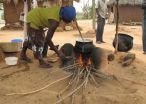(Press-News.org) Montreal, November 1, 2012 – As urban populations expand, downtown buildings are going nowhere but up. The huge energy needs of these skyscrapers mean that these towers are not only office buildings, they're polluters with smokestacks billowing out toxins from the rooftop. Our cities are dirtier than we think. New research from Concordia University just might clean them up.
By examining the trajectory and amount of air pollution from a building to its neighbours downwind, Concordia researchers Ted Stathopoulos and Bodhisatta Hajra have come up with environmentally friendly building guidelines for our modern cities. This provides a much-needed update to the industry standards developed decades ago by the American Society of Heating, Refrigerating and Air-Conditioning Engineers – the international technical society that sets the rules for building ventilation.
Stathopoulos – a professor in Concordia's Department of Building, Civil and Environmental Engineering – partnered with emerging researcher and recent Concordia graduate Hajra to pen the study, recently featured in the peer-reviewed journal, Building and Environment. To perform the research, they hunkered down in Concordia's cutting-edge wind tunnel laboratory, a huge underground research facility which allows engineers to test the atmospheric dispersion of pollution and toxins in any given setting.
"We created model configurations consisting of buildings of various sizes and shapes," says Stathopoulos, an inveterate researcher who was awarded the prestigious Davenport Medal by the International Association for Wind Engineering in September 2012.
Hajra, who received his doctorate during Concordia's fall convocation on October 30, goes on to explain: "we then placed our models downwind of a building that was emitting toxins to trace the path from polluter to polluted. That allowed us to see how much pollution was being absorbed by buildings downwind and where on those buildings that pollution was most concentrated."
Their findings show that the process by which air pollution spreads from one building's exhaust stack to another's intake is affected by the height and spacing between buildings, something that can be optimized by architects and engineers as new towers are constructed.
What does this mean for the future of downtown buildings? "We came up with three main guidelines for the placement of stack and intake in order to minimize the amount of air pollution that makes its way into downwind buildings," says Stathopoulos.
First, intake vents on buildings downwind of a polluter need to be placed upwind of that building's stack, and closer to its more sheltered wall. Second, air intakes should not be placed on rooftop locations downwind of a low stack and the protected wall of the emitting building. Lastly, increased spacing between buildings can reduce the possibility that pollutants from one will be re-ingested by another.
"While our research may not reduce the amount of outdoor pollution in our cities," explains Stathopoulos, "it can certainly help ensure that this same dirty air is not re-circulated indoors."
INFORMATION:
Partners in research: This study was funded by the Institut de recherche Robert-Sauvé en santé et en sécurité du travail (IRSST).
Related links:
Concordia's Department of Building, Civil and Environmental Engineering
Ted Stathopoulos: Research @ Concordia
Bodhisatta Hajra's profile page
Ted Stathopoulos awarded IAWE Senior Award
Source:
Cléa Desjardins
Senior advisor, media relations
University Communications Services
Concordia University
Phone: 514-848-2424, ext. 5068
Email: clea.desjardins@concordia.ca
Web: concordia.ca/now/media-relations
Twitter: @CleaDesjardins
Air pollution, gone with the wind
Concordia researchers propose new building guidelines to clean up city air
2012-11-01
ELSE PRESS RELEASES FROM THIS DATE:
Anthropocene continues to spark scientific debate
2012-11-01
Boulder, CO, USA – How have humans influenced Earth? Can geoscientists measure when human impacts began overtaking those of Earth's other inhabitants and that of the natural Earth system? Responding to increasing scientific recognition that humans have become the foremost agent of change at Earth's surface, organizers of this GSA technical session have brought together speakers and poster presentations from a variety of sources in order to answer these questions and define the "Geomorphology of the Anthropocene."
"Anthropocene" is a fairly new term (first used ca. 2002 ...
Scientists launch international study of open-fire cooking and air quality
2012-11-01
Contact: David Hosansky
hosansky@ucar.edu
303-497-8611
National Center for Atmospheric Research/University Corporation for Atmospheric Research
Zhenya Gallon
zhenya@ucar.edu
303-497-8607
National Center for Atmospheric Research/University Corporation for Atmospheric Research
Christine Wiedinmyer
christin@ucar.edu
303-497-1414
National Center for Atmospheric Research
Mary Hayden
mhayden@ucar.edu
303-497-8116
National Center for Atmospheric Research
Scientists launch international study of open-fire cooking and air quality
BOULDER -- Expanding ...
Genetic test results for Lynch syndrome improved with new computer program
2012-11-01
SALT LAKE CITY—Many patients who have genetic testing for Lynch syndrome, a hereditary predisposition to colon cancer, receive the inconclusive result "variants of uncertain clinical significance." This can be a problem, as people with Lynch syndrome have a much higher probability to develop colon cancer, and often develop colon cancer at an earlier age than is common among the general population; consequently, they need to begin screening at a much younger age.
Now, between two-thirds and three-fourths of these genetic variants can be classified into categories that ...
Brain may 'see' more than the eyes, study indicates
2012-11-01
Vision may be less important to "seeing" than is the brain's ability to process points of light into complex images, according to a new study of the fruit fly visual system currently published in the online journal Nature Communications.
University of Virginia researchers have found that the very simple eyes of fruit fly larvae, with only 24 total photoreceptors (the human eye contains more than 125 million), provide just enough light or visual input to allow the animal's relatively large brain to assemble that input into images.
"It blows open how we think about vision," ...
IU researchers report first effective treatment of tumors arising from common genetic disease NF1
2012-11-01
Physician-researchers at Indiana University School of Medicine have reported the first effective therapy for a class of previously untreatable and potentially life-threatening tumors often found in children.
Announcing their findings in the online first edition of Lancet Oncology, the researchers said the drug imatinib mesylate, marketed as Gleevec as a treatment for chronic myeloid leukemia, provided relief to a significant number of patients with plexiform neurofibromas, tumors caused by neurofibromatosis type 1, or NF1.
"Although this was a small study, the results ...
Super-rare, super-luminous supernovae are likely explosion of universe's earliest stars
2012-11-01
The most-distant, super-luminous supernovae found to date have been observed by an international team, including Raymond Carlberg of the University of Toronto's Department of Astronomy & Astrophysics. The stellar explosions would have occurred at a time when the universe was much younger and probably soon after the Big Bang.
"The objects are both unusually bright and unusually slow to fade. These are properties that are consistent with what is known as pair-instability supernova, a rare mechanism for explosion which is expected to happen for high-mass stars with almost ...
Stem cells could heal equine tendon injuries
2012-11-01
Tendon injuries affect athletic horses at all levels. Researchers from the University of Connecticut are studying the use of stem cells in treating equine tendon injuries. Their findings were published Oct. 16 in the Journal of Animal Science Papers in Press.
Tendon injuries in horses tend to worsen over time as damage to the tendon creates lesions. Currently, horse owners treat tendon injuries by resting the horse and then carefully exercising the horse to control the growth of scar tissue in the tendon. Unfortunately, this treatment does not always work.
"These injuries ...
LSUHSC research identifies new therapeutic target for Alzheimer's disease
2012-11-01
New Orleans, LA – Research led by Chu Chen, PhD, Associate Professor of Neuroscience at LSU Health Sciences Center New Orleans, has identified an enzyme called Monoacylglycerol lipase (MAGL) as a new therapeutic target to treat or prevent Alzheimer's disease. The study was published online November 1, 2012 in the Online Now section of the journal Cell Reports.
The research team found that inactivation of MAGL, best known for its role in degrading a cannabinoid produced in the brain, reduced the production and accumulation of beta amyloid plaques, a pathological hallmark ...
Rethinking reading
2012-11-01
Many educators have long believed that when words differ on only one sound, early readers can learn the rules of phonics by focusing on what is different between the words. This is thought to be a critical gateway to reading words and sentences.
But scientists at the University of Iowa are turning that thinking on its head. A recent study published in "Developmental Psychology" shows certain kinds of variation in words may help early readers learn better. When children see the same phonics regularities, embedded in words with more variation, they may learn these crucial ...
Laser-light testing of breast tumor fiber patterns helps show whose cancer is spreading
2012-11-01
Using advanced microscopes equipped with tissue-penetrating laser light, cancer imaging experts at Johns Hopkins have developed a promising, new way to accurately analyze the distinctive patterns of ultra-thin collagen fibers in breast tumor tissue samples and to help tell if the cancer has spread.
The Johns Hopkins researchers say their crisscrossing optical images, made by shining a laser back and forth across a biopsied tissue sample a few millionths of a meter thick, can potentially be used with other tests to more accurately determine the need for lymph node biopsy ...
LAST 30 PRESS RELEASES:
UVA’s Jundong Li wins ICDM’S 2025 Tao Li Award for data mining, machine learning
UVA’s low-power, high-performance computer power player Mircea Stan earns National Academy of Inventors fellowship
Not playing by the rules: USU researcher explores filamentous algae dynamics in rivers
Do our body clocks influence our risk of dementia?
Anthropologists offer new evidence of bipedalism in long-debated fossil discovery
Safer receipt paper from wood
Dosage-sensitive genes suggest no whole-genome duplications in ancestral angiosperm
First ancient human herpesvirus genomes document their deep history with humans
Why Some Bacteria Survive Antibiotics and How to Stop Them - New study reveals that bacteria can survive antibiotic treatment through two fundamentally different “shutdown modes”
UCLA study links scar healing to dangerous placenta condition
CHANGE-seq-BE finds off-target changes in the genome from base editors
The Journal of Nuclear Medicine Ahead-of-Print Tip Sheet: January 2, 2026
Delayed or absent first dose of measles, mumps, and rubella vaccination
Trends in US preterm birth rates by household income and race and ethnicity
Study identifies potential biomarker linked to progression and brain inflammation in multiple sclerosis
Many mothers in Norway do not show up for postnatal check-ups
Researchers want to find out why quick clay is so unstable
Superradiant spins show teamwork at the quantum scale
Cleveland Clinic Research links tumor bacteria to immunotherapy resistance in head and neck cancer
First Editorial of 2026: Resisting AI slop
Joint ground- and space-based observations reveal Saturn-mass rogue planet
Inheritable genetic variant offers protection against blood cancer risk and progression
Pigs settled Pacific islands alongside early human voyagers
A Coral reef’s daily pulse reshapes microbes in surrounding waters
EAST Tokamak experiments exceed plasma density limit, offering new approach to fusion ignition
Groundbreaking discovery reveals Africa’s oldest cremation pyre and complex ritual practices
First breathing ‘lung-on-chip’ developed using genetically identical cells
How people moved pigs across the Pacific
Interaction of climate change and human activity and its impact on plant diversity in Qinghai-Tibet plateau
From addressing uncertainty to national strategy: an interpretation of Professor Lim Siong Guan’s views
[Press-News.org] Air pollution, gone with the windConcordia researchers propose new building guidelines to clean up city air



